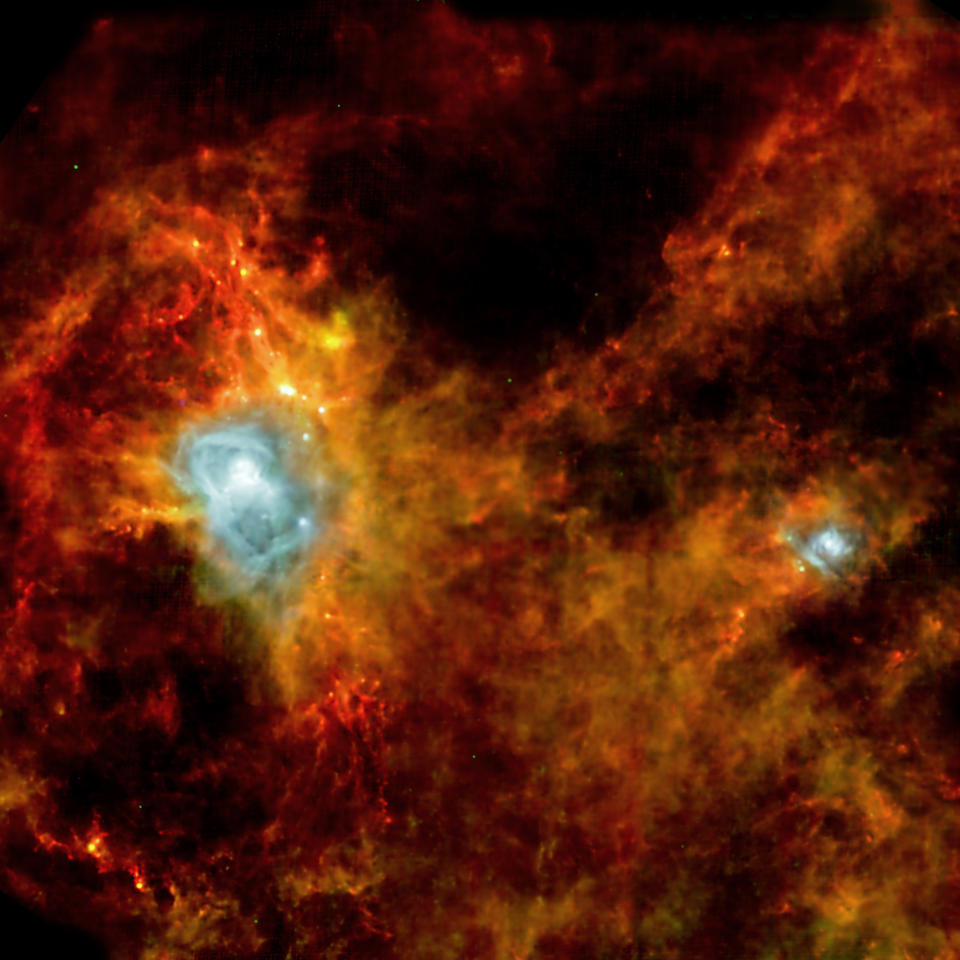A company will soon shift jobs from one downtown Detroit building to another.
But this much-celebrated move — by General Motors out of the Renaissance Center next year and into the new Hudson’s site development — could come at an extra cost to the state.
The planned relocation of GM’s global headquarters could trigger a “double dipping” of sorts in state corporate and development subsidy programs, according to a Free Press analysis.
The unique situation, which has not been previously reported, concerns an overlap period of up to five years in two subsidy programs: MEGA tax credits, aimed at retaining and encouraging business investment in Michigan, including by the Detroit Three automakers, and Transformational Brownfields, designed to spur redevelopment of blighted or obsolete building sites.
Specifically, the programs each make claims that relate to the 4.25% personal state income taxes of the GM employees who will move from the RenCen to the automaker’s new headquarters in the Hudson’s site office building.
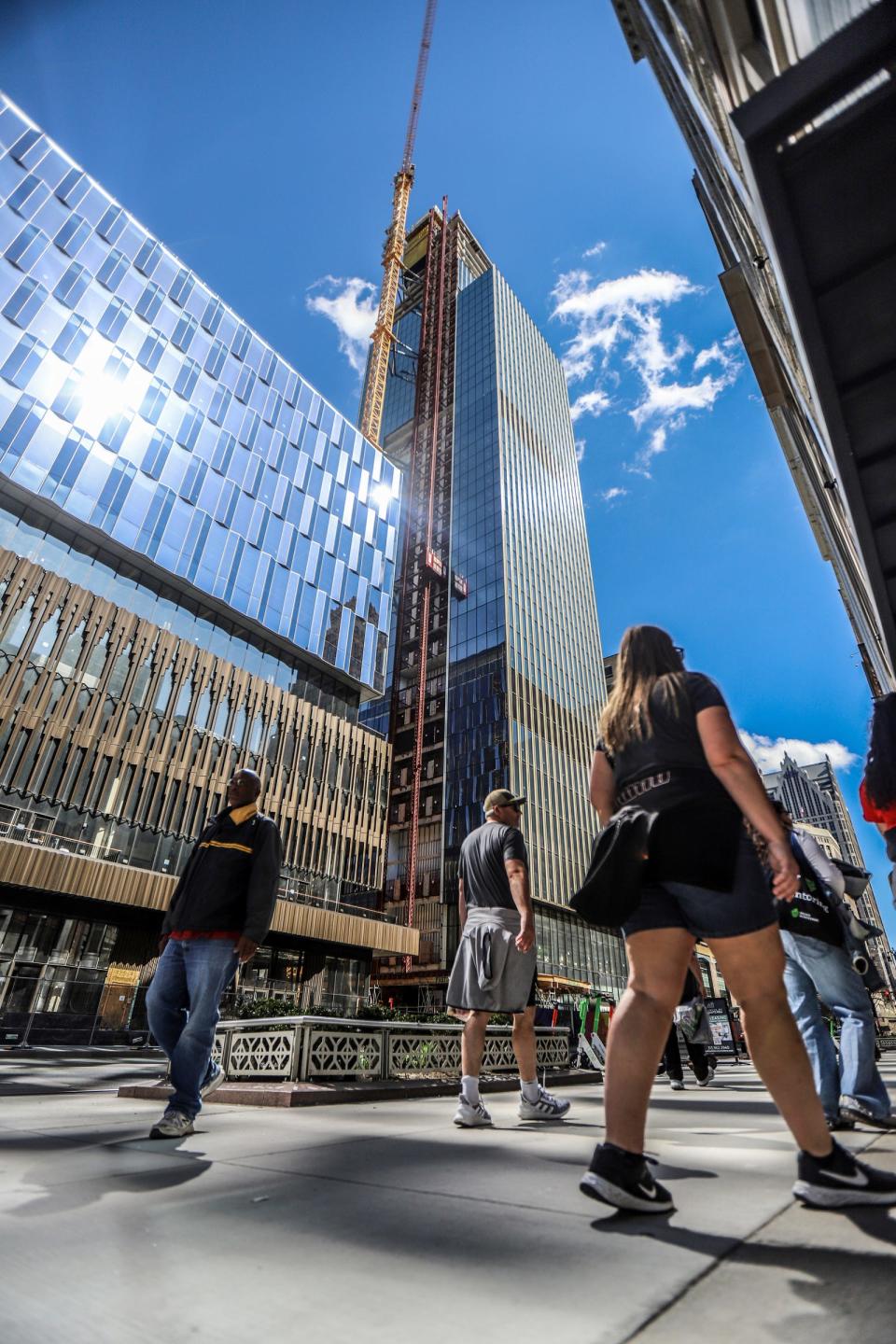
Under the MEGA tax credits deal with GM, which dates to 2009, the automaker can get a tax credit equal to 100% of the state income tax rate, multiplied by the total salaries and value of health care benefits of all its qualifying Michigan employees at multiple worksites across the state. Not all GM worksites are considered MEGA worksites, although the Renaissance Center is and the Hudson’s site is expected to be.
The MEGA tax credits were expected to be worth up to $205 million last year for GM and $200 million in 2022, documents say. This deal runs through Dec. 31, 2029, and then expires.
What GM’s headquarters employees pay in state income tax is also key for the Transformational Brownfield subsidy in place at the Hudson’s site, which goes to the benefit of the $1.4-billion project’s developer, Dan Gilbert’s real estate firm Bedrock.
The Transformational Brownfield allows Bedrock to capture multiple streams of future tax revenues generated by activities that take place at the Hudson’s site over periods of 20 to 30 years. One of those revenue streams is 50% of the state income taxes paid by each employee whose work location will be at the Hudson’s site once the buildings there are done. The state levies income taxes to pay for various services.
Under one potential scenario, for a GM employee who moves her office from the RenCen to the Hudson’s site, 150% of the value of their state income tax payments could go toward subsidies: 50% redirected for Bedrock, the other 100% for GM.
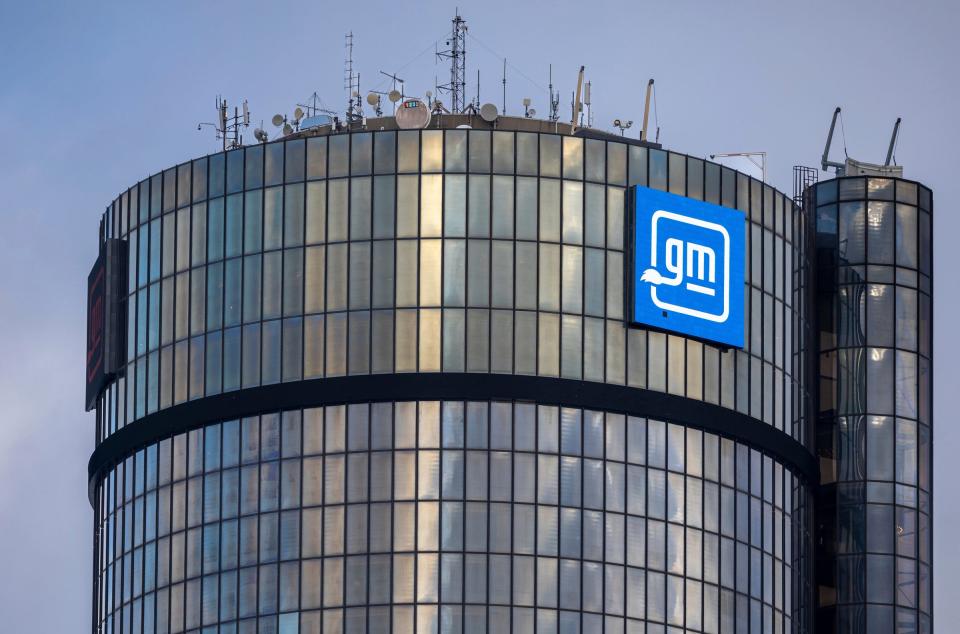
“So yes, they are writing checks based on the same cash flow,” said James Hohman, fiscal policy director for the Mackinac Center for Public Policy, a think tank that advocates for limited government and is critical of public subsidies for development.
“Lawmakers fooled themselves if they thought that these programs were costless in the first place, and they are doubly fooled now that companies are double dipping on the same flows,” he said.
To be sure, Bedrock hasn’t confirmed whether it intends to draw on the state income taxes of GM workers once they start arriving in the Hudson’s site office building in 2025.
The Transformational Brownfield program has traditionally been pitched by its proponents and beneficiaries as a tool for the attraction or creation of new jobs — not moving existing jobs to new buildings that are under the tax-capture umbrella.
A spokesman for the Michigan Economic Development Corp., which administers the MEGA and Transformational Brownfield programs, told the Free Press that because Bedrock hasn’t yet sought to identify GM as an official tenant for the Hudson’s site brownfield, it is too early to discuss what would or wouldn’t be allowed.
Bedrock did not respond to Free Press inquiries for this article.
As for the city, Hassan Beydoun, group executive for economic development for Detroit, called the double-dipping scenario “premature” and based on “unverified assumptions.”
“What is beyond question, however, is that GM keeping its headquarters in Detroit will greatly benefit the Motor City and its residents, including through income tax revenues,” Beydoun said in a statement. “The city of Detroit is thrilled about GM’s announcement and looks forward to learning more details about Bedrock and GM’s plans in the coming months.”
GM in April announced its plan to leave the RenCen in 2025 and start leasing the top two office floors of the new development’s 12-story office building. (The Hudson’s development also includes a neighboring 45-floor skyscraper — the second tallest in Detroit — that will be luxury housing and a hotel.)
The automaker hasn’t said how many employees it expects to have in the new building, a number that would be necessary for calculating the state’s potential payout.
However, its footprint will likely be much smaller at the Hudson’s site than it was at the Renaissance Center in the years before the COVID-19 pandemic, the rise of remote work options and the transfer of some employees to GM’s Warren campus.
Down to two floors
Commercial real estate brochures have showed the top two floors of the Hudson’s office building as containing just under 50,000 square feet each, with capacity for under 400 people on each floor.
Shortly before the pandemic, an amendment to GM’s MEGA tax credits deal eliminated an earlier requirement that the company keep a minimum 4,000 jobs at the Renaissance Center. The amendment also lowered the cost for the state of the tax credits by $325 million over 10 years.
As part of its 2022 application for MEGA tax credits, the most recent one publicly available, GM listed over 1,600 RenCen-assigned employees, with about 230 of them still working from home. The majority of the RenCen workers were in Tower 300.
Since then, GM’s population in the riverfront complex appears to have fallen. The company’s website reported 857 RenCen employees as of this past March; headcount figures have since been removed from the website.
Plenty more room
The new Hudson’s building contains about 400,000 square feet of total office space. With GM leasing only two floors of offices, about 100,000 square feet, that leaves plenty of room for more tenants. So far, Bedrock has yet to announce any other commercial tenants besides GM.
In the skyscraper next door, the Marriott-owned EDITION brand is to operate a luxury hotel that is scheduled to open in 2027 and collaborate on the tower’s planned residences. The total number of residential units will be 90, according to an annual report that Bedrock submitted last month to development officials.
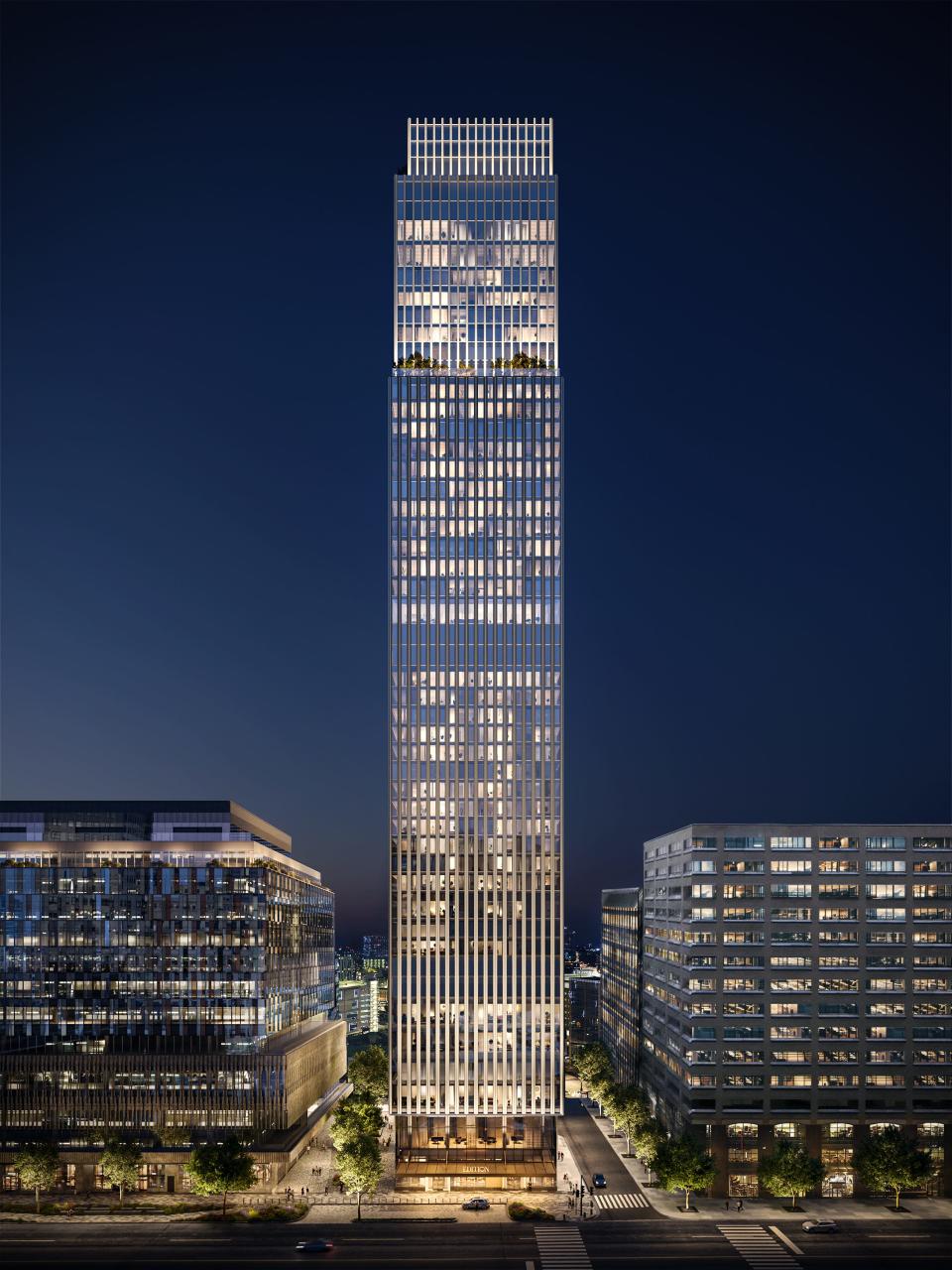
The EDITION Hotel was previously expected to open in 2025. Asked about the apparent delay, an EDITION representative referred all comment to Bedrock, which didn’t respond.
Not just a ‘reshuffling’
During debate over development incentives in Detroit, critics at times have questioned whether they will be used to create new jobs, rather than luring employers from older buildings into the new subsidized ones.
The topic came up during the summer of 2022 when Bedrock sought — and eventually won — Detroit City Council approval for the Hudson’s site a $60-million local tax abatement — an additional incentive on top of the Transformational Brownfield. Bedrock officials said at the time that the project, although already under construction, couldn’t be finished without the abatement.
During a public discussion about the abatement and hosted by some council members, a top executive with the Detroit Economic Growth Corp. addressed such concerns head-on. The DEGC had recommended that council approve the tax break.
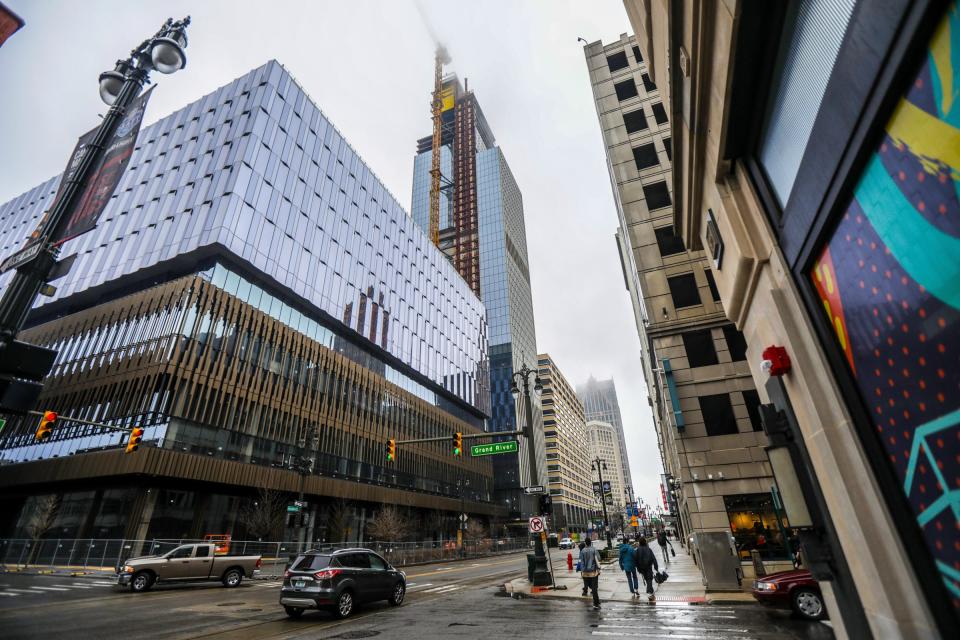
One caller during the June 20, 2022, public Zoom meeting, a resident of the city’s East English Village, asked, “How do we ensure this is not just a lateral move of companies and businesses from existing buildings downtown to the new Hudson project?”
“Because that’s my fear,” the caller said. “Are we going to end up with other vacant buildings like has happened in the past?”
In response, Kenyetta Bridges, the DEGC’s chief operating officer, said their economic forecasts assumed new jobs and businesses for the city. The DEGC’s projection for the Hudson’s site — office building and skyscraper —was 1,948 permanent, full-time-equivalent jobs over 10 years, which would translate to a $71.6 million net benefit for the city.
“Our projections are based upon new jobs coming into the city and new business coming into the city, not just a reshuffling of jobs in the city,” she said.
The DEGC didn’t respond to questions for this article.
Even with the GM relocation, there may well be enough space still available at the Hudson’s site for Bedrock to achieve the new job projections. Real estate brochures show six more office floors below the two GM floors in the office building, plus additional events, meeting and retail spaces below.
A longer-term view
One University of Michigan economist who analyzed the Hudson’s site and other subsidized Bedrock projects previously cautioned that any assessment should be done from a long-term viewpoint. It is important to know not only what jobs moved into the new buildings right away, but also what happened to any spaces in older Detroit buildings where some of those jobs might potentially move from.
For instance, if GM’s current space in the RenCen is snapped up by one or more companies that are new to Detroit or poised to grow, those RenCen jobs could ultimately be traced to Bedrock’s decision to expand the city’s building stock with the Hudson’s site development.
GM continues to own the original five towers of the RenCen and is working with Bedrock to determine future possibilities for the iconic property, including potential redevelopment.
City Council President Mary Sheffield was among those who voted for the Hudson’s site tax break in summer 2022. She issued a statement for this story Friday morning.
“My support for the Hudson deal came after careful deliberation and successfully negotiating a significant additional community benefits package. One of the main reasons I worked to secure those additional community benefits was the uncertainty of the office space market — so the promise of new jobs wasn’t a major factor in my decision-making process,” Sheffield said.
“With respect to GM moving its headquarters to the new Hudson’s Building, I am excited that GM has made another long-term commitment to be headquartered in Detroit and decided to retain ownership of the Renaissance Center. I look forward to being a part of the discussions to reimagine and ensure the future of the struggling but iconic and most recognizable part of Detroit’s skyline.”
How MEGA tax credits, Transformational Brownfields work
MEGA tax credits
-
GM receives a MEGA tax credit equal to 100% of the 4.25% state income tax rate, multiplied by the total wages and value of health care benefits of its qualified Michigan workers. To get the full 100%, it must maintain a minimum number of workers statewide.
-
The tax credits were worth $200 million for GM in 2022 and expected to be $205 million last year.
Transformational Brownfield
-
Bedrock can capture several tax revenue streams at the Hudson’s site.
-
The tax revenue streams are incremental increases in property taxes over 30 years; a 100% sales tax exemption on building construction materials; 100% of state income taxes of the construction laborers; 50% of state income taxes of future permanent, post-construction workers at the site; 100% of state income taxes for residents who will live in the development’s skyscraper.
Contact JC Reindl: 313-222-6631 or jcreindl@freepress.com. Follow him on X @jcreindl
This article originally appeared on Detroit Free Press: GM’s move to Hudson site could cause subsidies ‘double dip’
Signup bonus from



